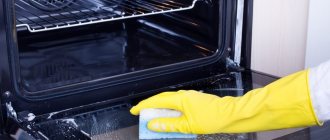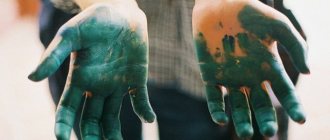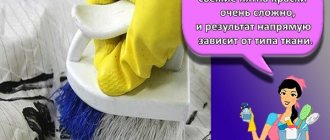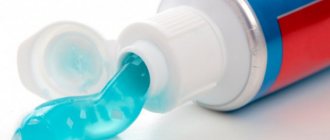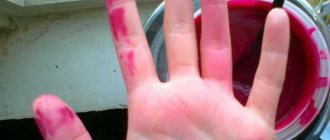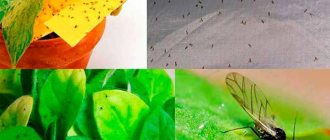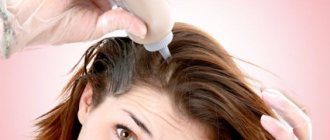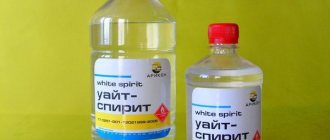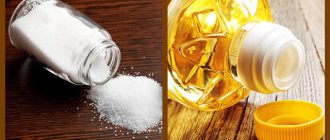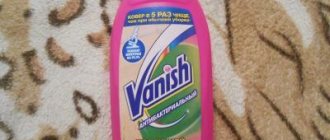Home page » Beauty » Nails
Author of the article
Svetlana Pavlikhina
Reading time: 4 minutes
AA
Iodine is a brown antiseptic for disinfecting wounds. The drug is also used to strengthen the nail plate and treat plants. When working, the product gets on things and the body. If stains disappear from the skin on their own within 24 hours, then it is difficult to wash off iodine from nails.
Process Features
The stains accidentally got on the nail plate, or the product was applied on purpose; it is not advisable to leave it - iodine eats into the structure and spoils the appearance. Pigmentation does not wash off with plain water; effective cleaning agents are selected.
The longer the mark remains on the nails, the more effort is spent on removal.
There are several options for quickly removing yellow stains from a plate.
For sensitive skin, those that do not cause allergies are suitable. If pigment gets on extended, varnished nails, clean with gentle movements.
The dark spot is not removed in one step; the procedure is repeated several times.
After cleansing, apply a nourishing moisturizer to your hands because stain removers are harsh on fabrics. Rubbing olive oil has a good effect.
Baking soda
Baking soda is one of the most famous, effective and fast-acting cleaning agents. To remove iodine stains, you need:
- wipe this stain with a wet sponge;
- sprinkle soda on it, cover with a napkin, which should first be moistened with water;
- it will take eight to ten hours for the baking soda to do its job;
- After the specified time has passed, it is necessary to wash the stain with water using one or another detergent.
If after the procedure the problem has not been completely resolved, it is recommended to repeat the procedure again.
Why does iodine eat into nails?
This is an active remedy. Once on the skin or plate, the substance reacts with other chemical components that make up the tissue. This is due to its penetration into the layers of the epidermis.
The body needs a natural element for the normal functioning of organs and systems.
When the thyroid gland does not produce iodine in full, drops of the substance that fall on the skin are quickly absorbed into the tissue structure.
If there is an excess, most of the iodine evaporates from the surface of the nail or skin along with alcohol vapor. As a result, the stain does not disappear, but gradually fades .
Potato starch
Erasing iodine stains with potato starch is one of the most economical, but no less effective methods. To remove a stain, you need:
- take a potato;
- cut it into two parts;
- wipe the dirty area with it.
As an alternative, you can use potato starch in its pure form. To do this, the powder is diluted with water so that a paste is formed. The resulting mass is applied to the stain, which is covered with a damp cloth and left for six to eight hours. After time, the paste should be removed and the area where the stain was washed with detergent.
Methods and means of cleaning
Fresh pigment can be easily washed off with a warm solution with the addition of a detergent. There are other cleaning options.
Iodine removers
There are several effective ways.
| Means | Recommendations |
| Medical alcohol | Moisten a cotton pad and apply it to the plate in a circular motion. If there are wounds on the skin near the treated area, it is advisable not to touch them |
| Ammonia alcohol | Diluted with water in a 1:1 ratio, use for baths. Fingers are immersed in liquid for 15-20 minutes |
| Lemon juice, hydrogen peroxide | The products have the same effect on the pigment spot. The soaked cotton wool is applied to the stained finger and secured with an adhesive plaster. After removing the application after some time, check if the stain has not disappeared, repeat the procedure |
| Nail polish remover | Moisten a cotton pad with a product containing acetone and try to wipe off the iodine stain |
| Baking soda | The powder is gently rubbed into the plate, left for several minutes, then washed off |
| Vegetable oil | Lubricate the pigment and do not remove it until the paint turns pale. The product is recommended to be used before bedtime |
To achieve the result, toothpaste with a whitening effect, evenly distributed over the stained plate, will help. Wait for the composition to be absorbed, then wash off. The stain will not be completely removed in one go, but will become less noticeable.
Quick Methods
It is possible to erase yellow-brown marks without a trace as soon as the liquid hits the plate. Procrastination complicates the process and makes it lengthy.
The following options will speed up the procedure:
- diluted table vinegar is poured into a small container, fingers are immersed in it for half an hour and removed so that skin irritation does not develop;
- make baths with sea salt (the product is more effective than citric acid);
- dilute a crushed tablet of ascorbic acid in water, keep the stained fingers in the liquid for several minutes.
Stain removers provide quick results. Use chemicals with caution; do not use them on manicures or in the presence of cracks, cuts, or other skin defects.
How to remove iodine from nails?
Iodine nail masks are a good strengthening agent, only with consequences in the form of yellowness. You have to think about how to remove iodine from cuticles, nails, and finger skin after the strengthening session.
Lemon juice. You can carefully apply the juice to a cotton pad and wipe off the yellowness. Or cut a lemon in half, crush the middle and stick all your fingers in there. One half is enough to clean both hands; the nails additionally receive a nourishing mask and whitening peeling for the inside of the nail plate. After the procedure, the remaining juice is removed with running water, hands are lubricated with olive oil or rich cream. This method is absolutely not suitable if there are burrs, cuts, or wounds.
We recommend reading: You can defeat cockroaches without chemicals!
Iodine is not as scary as it seems at first glance. The above are useful and pleasant ways to get rid of such stains. You can try everything and get real pleasure from solving the problem.
Features of cleaning depending on the type of nail coating
If iodine gets on your extended nails
Not all methods suggested in the table are applicable on artificial nails. Aggressive means lead to delamination of the composition, which necessitates re-building.
Harmless cleaning options are vegetable oil, soda baths, toothpaste. It is wiser not to remove iodine from extended nails, but to apply a layer of dark varnish on top.
Ways and means to remove iodine from shellac (gel polish)
All known methods, used with caution, will help remove antiseptic from shellac. Acetone, paint remover, and alcohol-containing compounds turn a glossy surface into a matte one.
Brown stains from gel polish must be removed immediately. It quickly eats into the paint layer and remains on it in the form of a yellow mark, which is removed with repeated vinegar baths.
Traditional recipes for removing iodine from the skin of the face and hands
To remove traces of iodine from the skin, it is not necessary to use professional products. Citrus fruits, salt, honey and other ingredients that can be found in almost every home also help whiten your hands and face.
Method No. 1. Vegetable oil
Instead of butter, any rich cream will do. The essence of the procedure is that fat breaks down iodine in the upper layers of the epithelium. It should be noted that this method is suitable even for the delicate skin of babies, so it can be used without fear.
The cream or oil should be rubbed into the stain and left for 10 minutes - during this time the mark will begin to lighten. Next, the product should be washed off with laundry soap and warm water.
Method No. 2. Lemon juice
Citrus juice removes various stains from textiles, but it also copes with traces of iodine. This component is added to some cosmetics for skin whitening, so there is no doubt about its effectiveness when blots get on your hands and face.
First, soak a cotton swab in freshly squeezed lemon juice and rub the stain. The procedure is repeated until the contaminated area turns pale.
Note! Many people have an allergic reaction to citrus fruits, so an allergy test must be performed before the procedure. A drop of juice is applied to a small area of the skin of the hand, and if after 10 minutes a red spot appears and the hand begins to itch, this means a tendency to allergies.
Method No. 3. Alcohol
Rubbing alcohol can be purchased at almost every pharmacy. If you can’t find it, then vodka without impurities will do.
To remove a stain, you need to moisten a swab and wipe the stain - it will immediately begin to fade and will soon disappear.
We recommend:
Vanish for carpets - instructions for use
Attention! Ethyl alcohol should not be applied to delicate areas, or to the skin of a child. The fact is that the compound dries the skin very much and can cause irritation.
Method No. 4. Hydrogen peroxide
It is recommended to keep this product in every home medicine cabinet, as it is indispensable for cuts and contaminations. It has a low price and is sold in every pharmacy. To remove a stain, you need to apply a cotton swab soaked in peroxide to it. After a few seconds, the mark will begin to disappear, and then the area of the skin should be lightly rubbed.
Method No. 5. Sea salt
Some people may develop a tolerance to alcohol, honey, citrus fruits, or hydrogen peroxide. In this case, sea salt, which is sold in all stores of any grocery chain, can help. You should take warm water into an enamel pan, stir 2 tbsp in it. l. salt and lower your hands for 5 minutes. Traces of iodine will disappear faster if during the procedure you gently rub the contaminated areas with a soft sponge.
Important! Do not draw hot water, as the skin of your hands may deteriorate. The ideal temperature is 35-40˚C.
If iodine gets not only on your hands, but also on your face and body, then you can take a salt bath - it will steam the skin and cleanse it of stains. It is recommended to use special bath salts.
Method No. 6. Scrub with honey
To prepare the scrub you need to take the following ingredients:
- fine salt (preferably sea salt, but it must be ground first);
- Bee Honey.
The components need to be mixed well, then apply the mask to the skin and massage lightly. At the end, the mixture is washed off with warm water, and the skin is treated with a rich moisturizer.
The principle of operation of the scrub is a mechanical effect on the skin, during which the upper epithelial cells are removed along with absorbed contaminants. If iodine gets on an area with thin skin, for example, on the palm, inside of the elbow or face, then gentler methods should be used.
There are special and basic rules
They include:
- Some chlorine-containing products and hydrogen peroxide leave traces behind. So be careful and test them on unnecessary things;
- Before treating the stain, it is necessary to clean the surface from dust
- You should be careful with concentration. Start erasing the stain with a small concentration first, and then increase it as needed;
- you should rinse the same area after each application of the product;
- the direction of the sponge should be from the periphery to the center;
- Before applying, you need to thoroughly lather the iodine stain and leave it for a while;
- try to scrub immediately after the incident has started. Old stains are much more difficult to remove.
How to remove old iodine stains?
In some cases, it is not possible to remove traces of iodine that have appeared long ago. You can try to get rid of them on fabric using hydrogen peroxide and vinegar. The first is applied to a cotton swab and the contaminated area begins to be treated. Clean until the stain becomes completely light and the iodine no longer leaves traces on the tampon. Then concentrated acetic acid is applied to the stain, after which a chemical reaction begins, during which the iodine crystallizes. Solid crystals can be easily removed.
How to remove iodine from a table
If iodine ends up on a white table, then this problem needs to be solved quickly. You will find a lot of information on this topic on the Internet, but there are no tips for eliminating such stains. People often advise using alcohol for this purpose, or using detergents. But none of these methods are suitable; they are likely to aggravate the situation. It’s better not to remove iodine on the countertop at all!
Almost all table coverings are equipped with a large number of protective layers. They do not allow liquids to seep deeper. In addition, iodine itself evaporates at the temperature maintained in the living room. So, the stain will disappear after a while, and what remains of it can be quite easily cleaned with medical alcohol.
